Get 50% OFF Yearly and Lifetime Plans This Black Friday

What Is a Rhetorical Analysis and How to Write a Great One

By Helly Douglas
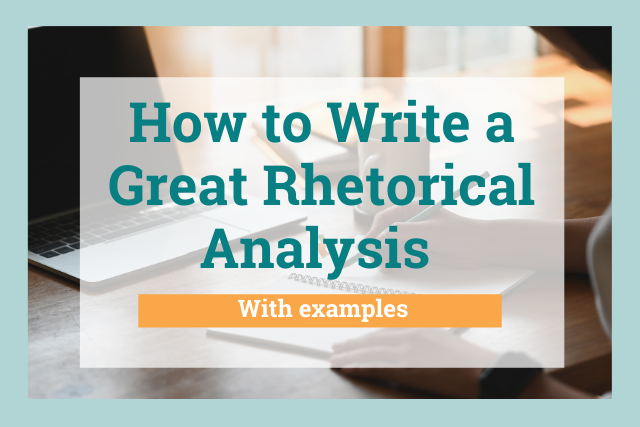
Do you have to write a rhetorical analysis essay? Fear not! We’re here to explain exactly what rhetorical analysis means, how you should structure your essay, and give you some essential “dos and don’ts.”
What is a Rhetorical Analysis Essay?
How do you write a rhetorical analysis, what are the three rhetorical strategies, what are the five rhetorical situations, how to plan a rhetorical analysis essay, creating a rhetorical analysis essay, examples of great rhetorical analysis essays, final thoughts.
A rhetorical analysis essay studies how writers and speakers have used words to influence their audience. Think less about the words the author has used and more about the techniques they employ, their goals, and the effect this has on the audience.
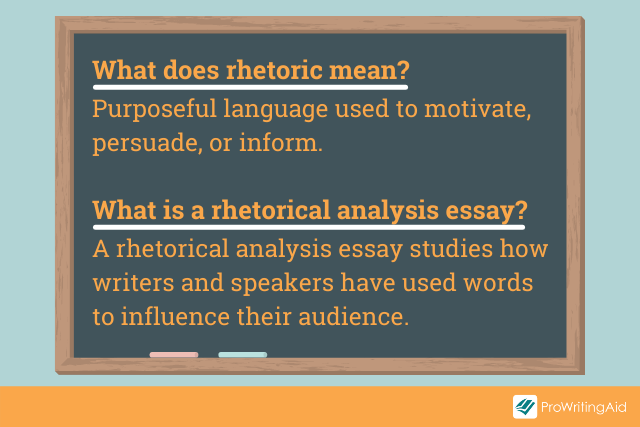
In your analysis essay, you break a piece of text (including cartoons, adverts, and speeches) into sections and explain how each part works to persuade, inform, or entertain. You’ll explore the effectiveness of the techniques used, how the argument has been constructed, and give examples from the text.
A strong rhetorical analysis evaluates a text rather than just describes the techniques used. You don’t include whether you personally agree or disagree with the argument.
Structure a rhetorical analysis in the same way as most other types of academic essays . You’ll have an introduction to present your thesis, a main body where you analyze the text, which then leads to a conclusion.
Think about how the writer (also known as a rhetor) considers the situation that frames their communication:
- Topic: the overall purpose of the rhetoric
- Audience: this includes primary, secondary, and tertiary audiences
- Purpose: there are often more than one to consider
- Context and culture: the wider situation within which the rhetoric is placed
Back in the 4th century BC, Aristotle was talking about how language can be used as a means of persuasion. He described three principal forms —Ethos, Logos, and Pathos—often referred to as the Rhetorical Triangle . These persuasive techniques are still used today.
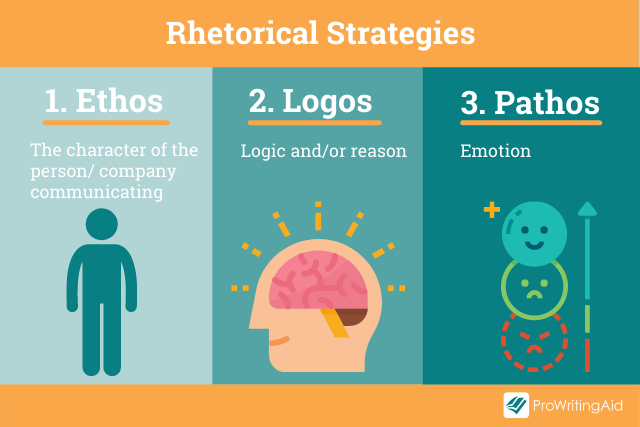
Rhetorical Strategy 1: Ethos
Are you more likely to buy a car from an established company that’s been an important part of your community for 50 years, or someone new who just started their business?
Reputation matters. Ethos explores how the character, disposition, and fundamental values of the author create appeal, along with their expertise and knowledge in the subject area.
Aristotle breaks ethos down into three further categories:
- Phronesis: skills and practical wisdom
- Arete: virtue
- Eunoia: goodwill towards the audience
Ethos-driven speeches and text rely on the reputation of the author. In your analysis, you can look at how the writer establishes ethos through both direct and indirect means.
Rhetorical Strategy 2: Pathos
Pathos-driven rhetoric hooks into our emotions. You’ll often see it used in advertisements, particularly by charities wanting you to donate money towards an appeal.
Common use of pathos includes:
- Vivid description so the reader can imagine themselves in the situation
- Personal stories to create feelings of empathy
- Emotional vocabulary that evokes a response
By using pathos to make the audience feel a particular emotion, the author can persuade them that the argument they’re making is compelling.
Rhetorical Strategy 3: Logos
Logos uses logic or reason. It’s commonly used in academic writing when arguments are created using evidence and reasoning rather than an emotional response. It’s constructed in a step-by-step approach that builds methodically to create a powerful effect upon the reader.
Rhetoric can use any one of these three techniques, but effective arguments often appeal to all three elements.
The rhetorical situation explains the circumstances behind and around a piece of rhetoric. It helps you think about why a text exists, its purpose, and how it’s carried out.
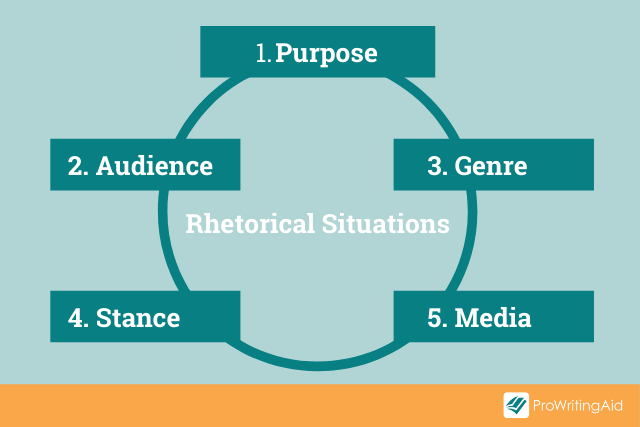
The rhetorical situations are:
- 1) Purpose: Why is this being written? (It could be trying to inform, persuade, instruct, or entertain.)
- 2) Audience: Which groups or individuals will read and take action (or have done so in the past)?
- 3) Genre: What type of writing is this?
- 4) Stance: What is the tone of the text? What position are they taking?
- 5) Media/Visuals: What means of communication are used?
Understanding and analyzing the rhetorical situation is essential for building a strong essay. Also think about any rhetoric restraints on the text, such as beliefs, attitudes, and traditions that could affect the author's decisions.
Before leaping into your essay, it’s worth taking time to explore the text at a deeper level and considering the rhetorical situations we looked at before. Throw away your assumptions and use these simple questions to help you unpick how and why the text is having an effect on the audience.

1: What is the Rhetorical Situation?
- Why is there a need or opportunity for persuasion?
- How do words and references help you identify the time and location?
- What are the rhetoric restraints?
- What historical occasions would lead to this text being created?
2: Who is the Author?
- How do they position themselves as an expert worth listening to?
- What is their ethos?
- Do they have a reputation that gives them authority?
- What is their intention?
- What values or customs do they have?
3: Who is it Written For?
- Who is the intended audience?
- How is this appealing to this particular audience?
- Who are the possible secondary and tertiary audiences?
4: What is the Central Idea?
- Can you summarize the key point of this rhetoric?
- What arguments are used?
- How has it developed a line of reasoning?
5: How is it Structured?
- What structure is used?
- How is the content arranged within the structure?
6: What Form is Used?
- Does this follow a specific literary genre?
- What type of style and tone is used, and why is this?
- Does the form used complement the content?
- What effect could this form have on the audience?
7: Is the Rhetoric Effective?
- Does the content fulfil the author’s intentions?
- Does the message effectively fit the audience, location, and time period?
Once you’ve fully explored the text, you’ll have a better understanding of the impact it’s having on the audience and feel more confident about writing your essay outline.
A great essay starts with an interesting topic. Choose carefully so you’re personally invested in the subject and familiar with it rather than just following trending topics. There are lots of great ideas on this blog post by My Perfect Words if you need some inspiration. Take some time to do background research to ensure your topic offers good analysis opportunities.
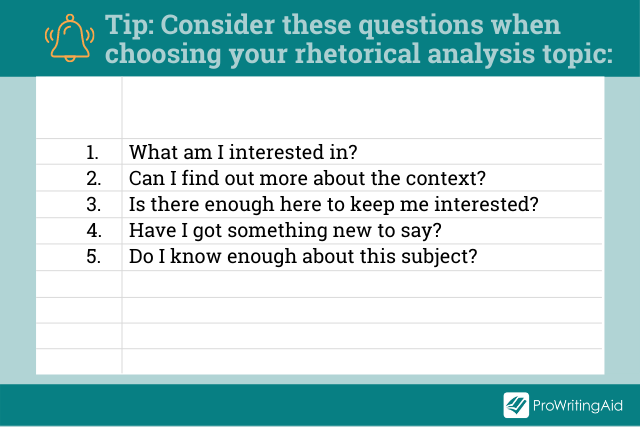
Remember to check the information given to you by your professor so you follow their preferred style guidelines. This outline example gives you a general idea of a format to follow, but there will likely be specific requests about layout and content in your course handbook. It’s always worth asking your institution if you’re unsure.
Make notes for each section of your essay before you write. This makes it easy for you to write a well-structured text that flows naturally to a conclusion. You will develop each note into a paragraph. Look at this example by College Essay for useful ideas about the structure.
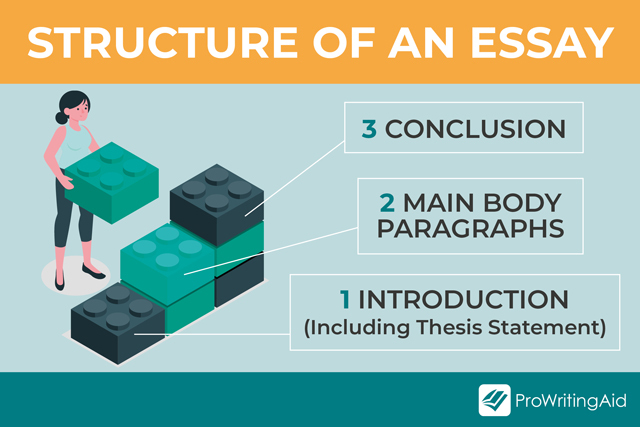
1: Introduction
This is a short, informative section that shows you understand the purpose of the text. It tempts the reader to find out more by mentioning what will come in the main body of your essay.
- Name the author of the text and the title of their work followed by the date in parentheses
- Use a verb to describe what the author does, e.g. “implies,” “asserts,” or “claims”
- Briefly summarize the text in your own words
- Mention the persuasive techniques used by the rhetor and its effect
Create a thesis statement to come at the end of your introduction.
After your introduction, move on to your critical analysis. This is the principal part of your essay.
- Explain the methods used by the author to inform, entertain, and/or persuade the audience using Aristotle's rhetorical triangle
- Use quotations to prove the statements you make
- Explain why the writer used this approach and how successful it is
- Consider how it makes the audience feel and react
Make each strategy a new paragraph rather than cramming them together, and always use proper citations. Check back to your course handbook if you’re unsure which citation style is preferred.
3: Conclusion
Your conclusion should summarize the points you’ve made in the main body of your essay. While you will draw the points together, this is not the place to introduce new information you’ve not previously mentioned.
Use your last sentence to share a powerful concluding statement that talks about the impact the text has on the audience(s) and wider society. How have its strategies helped to shape history?

Before You Submit
Poor spelling and grammatical errors ruin a great essay. Use ProWritingAid to check through your finished essay before you submit. It will pick up all the minor errors you’ve missed and help you give your essay a final polish. Look at this useful ProWritingAid webinar for further ideas to help you significantly improve your essays. Sign up for a free trial today and start editing your essays!
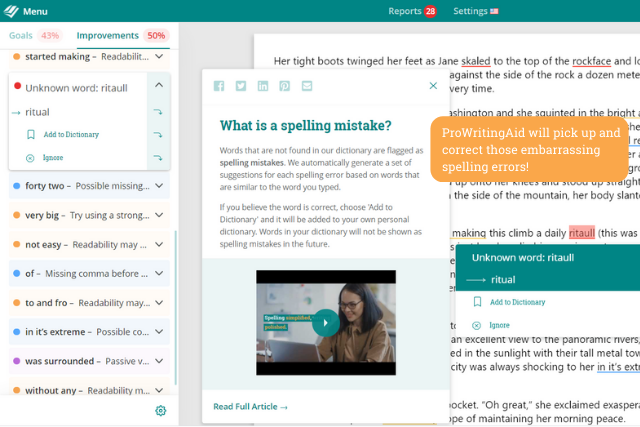
You’ll find countless examples of rhetorical analysis online, but they range widely in quality. Your institution may have example essays they can share with you to show you exactly what they’re looking for.
The following links should give you a good starting point if you’re looking for ideas:
Pearson Canada has a range of good examples. Look at how embedded quotations are used to prove the points being made. The end questions help you unpick how successful each essay is.
Excelsior College has an excellent sample essay complete with useful comments highlighting the techniques used.
Brighton Online has a selection of interesting essays to look at. In this specific example, consider how wider reading has deepened the exploration of the text.
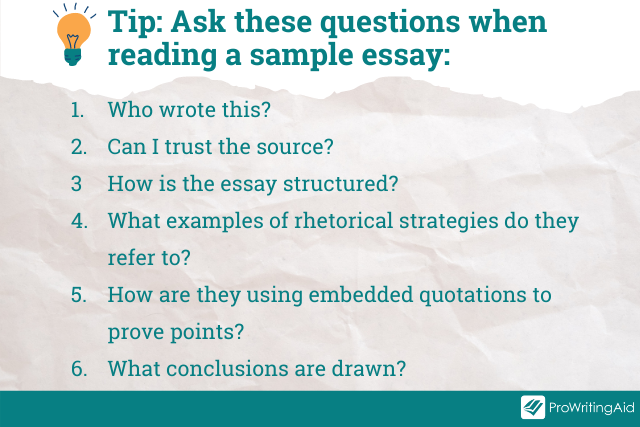
Writing a rhetorical analysis essay can seem daunting, but spending significant time deeply analyzing the text before you write will make it far more achievable and result in a better-quality essay overall.
It can take some time to write a good essay. Aim to complete it well before the deadline so you don’t feel rushed. Use ProWritingAid’s comprehensive checks to find any errors and make changes to improve readability. Then you’ll be ready to submit your finished essay, knowing it’s as good as you can possibly make it.
Try ProWritingAid's Editor for Yourself

Be confident about grammar
Check every email, essay, or story for grammar mistakes. Fix them before you press send.
Helly Douglas
Helly Douglas is a UK writer and teacher, specialising in education, children, and parenting. She loves making the complex seem simple through blogs, articles, and curriculum content. You can check out her work at hellydouglas.com or connect on Twitter @hellydouglas. When she’s not writing, you will find her in a classroom, being a mum or battling against the wilderness of her garden—the garden is winning!
Get started with ProWritingAid

All features—half price
Save 50% on yearly and lifetime plans
this Black Friday.
Grab the discount while it lasts.
Visit our Help Center or let's stay in touch via:
Rhetorical Analyses
A rhetorical analysis considers all elements of the rhetorical situation--the audience, purpose, medium, and context--within which a communication was generated and delivered in order to make an argument about that communication. A strong rhetorical analysis will not only describe and analyze the text, but will also evaluate it; that evaluation represents your argument.
- Description: What does this text look like? Where did you find the text? Who sponsored it? What are the rhetorical appeals? (i.e. calm music in the background of a commercial establishes pathos) When was it written?
- Analysis: Why does the author incorporate these rhetorical appeals? (For example, why does the author incorporate calm music? What is the point of the pathos?) How would the reception of this text change if it were written today, as opposed to twenty years ago? What is left out of this text and why? Should there be more logos in the ad? Why?
- Evaluation: Is the text effective? Is the text ethical? What might you change about this text to make it more persuasive?
Rhetoric Defined
- Classically, "the art of persuasion".
- "About using language purposefully, in order to get something done in the world" ("What is Rhetoric").
- "Something that allows you to formulate ethical reading strategies [...] but also to invent your own responses to the world" ("What is Rhetoric").
Keywords and Concepts
Following are some basic terms and concepts (far from inclusive) that you should consider and use in a rhetorical analysis.
Rhetorical Situation
The rhetorical situation identifies the relationship among the elements of any communication--audience, author (rhetor), purpose, medium, context, and content.
Spectator, listeners, and/or readers of a performance, a speech, a reading, or printed material. Depending on the author's/writer's perception, an audience may be real (actually listening or reading), invoked (those to whom the writer explicitly writes) or imagined(those who the writer believes will read/hear her work) (Dept. of English)
Author/Rhetor/Speaker/Writer
The person or group of people who composed the text.
Purpose of the Author
The reason for communicating; the expected or intended outcome.
The delivery method, which varies by type of text:
- Alphabetic Text (for example, written speech, newspaper editorial, essay, passage out of a novel, poetry)
- Images (for example, TV commercials, advertisements in magazines or on websites)
- Sound (for example, radio or TV commercials, a website advertisement, speeches)
- Multimodal texts (YouTube videos, performances, digital stories)
The time, place, public conversations surrounding the text during its original generation and delivery; the text may also be analyzed within a different context such as how an historical text would be received by its audience today.
The main idea, thesis, opinion, or belief of an argument that the author must prove. The claim should be debatable and answer the question, "What's the point?"
The statements given to back up the claim. These can take the form of facts, data, personal experience, expert opinion, evidence from other texts or sources, emotional appeals, or other means. The more reliable and comprehensive the support, the more likely the audience is to accept the claim.
The connection, often unstated and assumed, between the claim and the supporting reason(s), or support. The warrant is the assumption that makes the claim seem plausible. More specifically, warrants are the beliefs, values, inferences and/or experiences that the writers/speakers assume they share with the audience. If the audience doesn't share the writers'/speakers' assumptions within the text, the argument will not be effective.
Rhetorical Triangle
The elements of the rhetorical situation interact with and influence one another. In learning to write an analysis, it is thus helpful to think about the relationship among these elements within the rhetorical triangle. By doing this, writers will be able to better understand how the elements of each text come together (often overlap) to make an argument or persuade an audience.
The authority or credibility of the author. Can refer to any of the following: the actual character of the speaker/writer, the character of the writer as it is presented in a text, or as a series of ground rules/customs, which are negotiated between speaker, audience, and specific traditions or locations. The speaker must convince the audience of their credibility through the language they use and through the delivery, or embodied performance, of their speech.
Did you analyze ethos enough in your essay?
- Have you looked at what experiences or claims to authority qualify this author to speak or write?
- Have you considered the credibility and moral character of the writer/speaker?
- Have you considered the design or appearance of the text you are analyzing? Does it look professional? What can you say about the author based on the appearance of the text alone?
Emotional appeals to the audience to evoke feelings of pity, sympathy, tenderness, or sorrow. The speaker may also want the audience to feel anger, fear, courage, love, happiness, sadness, etc.
Have you analyzed pathos enough in your essay?
- Have you considered how the author appeals to the emotions of the reader/viewer?
- How does the author establish a bond with his audience?
- How might the author change his strategy if he was trying to establish a bond with a different audience?
- Have you considered your own personal reaction to the background music of this advertisement?
- What kinds of feelings do the colors that the author uses provoke?
- What other images in the text provoke an emotional response? Why would the author include these images?
In classical rhetoric, logos is the means of persuasion by demonstration of the truth, real or apparent, the reasons or supporting information used to support a claim, the use of logic or reason to make an argument. Logos can include citing facts and statistics, historical events, and other forms of fact based evidence.
Do you analyze logos enough in your essay?
- How does the author back up his argument in this text? Does he incorporate facts, statistics, or numbers?
- Have you considered how logical the author's argument is?
- Are the claims this author is making realistic?
- Does the author consider alternative arguments?
The right time to speak or write; advantageous, exact, or critical time; a window of time during which action is most effective. (Ex. Martin Luther King Jr.'s "I Have a dream speech was delivered at the right moment in history—in the heat of civil rights debates.)
Literally, stasis is "a stand" or a "resting place" in an argument where opponents agree on what the issue is but disagree on what to do about it. The skilled rhetor is able to move the argument away from stasis. (Ex. Rhetor A asserts that abortion is murder. Rhetor B asserts that abortion is not murder. This is the point of stasis. The argument cannot rest here indefinitely. One of these rhetors must get the argument beyond the issue of murder.)
501 E. High Street Oxford, OH 45056
- Online: Miami Online
- Main Operator 513-529-1809
- Office of Admission 513-529-2531
- Vine Hotline 513-529-6400
- Emergency Info https://miamioh.edu/emergency
1601 University Blvd. Hamilton, OH 45011
- Main Operator 513-785-3000
- Office of Admission 513-785-3111
- Campus Status Line 513-785-3077
- Emergency Info https://miamioh.edu/regionals/emergency
4200 N. University Blvd. Middletown, OH 45042
- Main Operator 513-727-3200
- Office of Admission 513-727-3216
- Campus Status 513-727-3477
7847 VOA Park Dr. (Corner of VOA Park Dr. and Cox Rd.) West Chester, OH 45069
- Main Operator 513-895-8862
- From Middletown 513-217-8862
Chateau de Differdange 1, Impasse du Chateau, L-4524 Differdange Grand Duchy of Luxembourg
- Main Operator 011-352-582222-1
- Email [email protected]
- Website https://miamioh.edu/luxembourg
217-222 MacMillan Hall 501 E. Spring St. Oxford, OH 45056, USA
- Main Operator 513-529-8600
Initiatives
- Miami THRIVE Strategic Plan
- Miami Rise Strategic Plan
- Boldly Creative
- Annual Report
- Moon Shot for Equity
- Miami and Ohio
- Majors, Minors, and Programs
- Inclusive Excellence
- Employment Opportunities
- University Safety and Security
- Parking, Directions, and Maps
- Equal Opportunity
- Consumer Information
- Land Acknowledgement
- Privacy Statement
- Title IX Statement
- Report an Accessibility Issue
- Annual Security and Fire Safety Report
- Report a Problem with this Website
- Policy Library

IMAGES
VIDEO